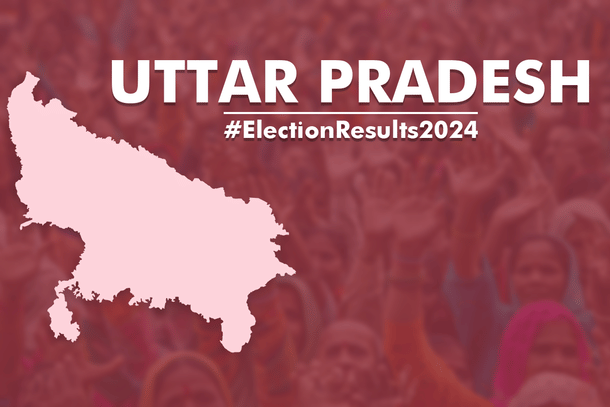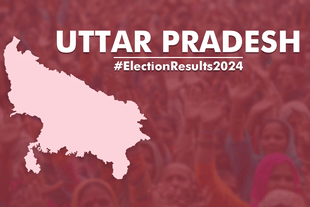Uttar Pradesh
In Maps: What Really Happened In Uttar Pradesh
Venu Gopal Narayanan
Jun 16, 2024, 12:57 PM | Updated 12:57 PM IST
Save & read from anywhere!
Bookmark stories for easy access on any device or the Swarajya app.


The Bharatiya Janata Party (BJP) failed to cross the halfway mark in the recently-concluded general elections primarily because of its sub-par performance in Uttar Pradesh (UP).
Belying almost all pre-poll surveys, which predicted that the BJP would sweep around 70 of 80 seats in UP, it ended up winning only 33, and its allies three.
Instead, the Samajwadi Party (SP) won 37 seats, its ally the Congress won six, and an unallied candidate won Nagina, totalling 44 seats.
This was unexpected, particularly since the index of opposition unity was lower than in 2019, with the Bahujan Samaj Party (BSP) contesting on its own as a third force, and with the BJP and its existing partner, the Apna Dal, gaining two minor allies – the Rashtriya Lok Dal (RLD) of Jayant Chaudhary, and OP Rajbhar’s SBSP.


As a gains/hold map below shows, the BJP+ combine suffered a secular, state-wide negative vote swing of almost eight per cent in 78 of 80 seats, lost 28 of the 64 seats it won in 2019, and ended up just half a percentage point ahead of the SP+ coalition.
In fact, the BJP made only a solitary gain, in Amroha seat, and that too only because the BSP split the vote. The other gain for its coalition in Bijnor was secured by its ally, the RLD, and again, courtesy the BSP who locked up a fifth of the vote in a low-scoring triangular contest.
Of the 14 seats in Awadh, in central UP, the BJP managed to retain only four of the 13 it won in 2019 (it won 11 of 14 in 2014). Also, note how the SP+ has managed to hold its own in eastern UP (holds marked in pale blue), a region which continues to confound the BJP in election after election.

Next, vote share distribution maps of the BJP+, the SP+, and the BSP.
Note how poorly the BJP+ performed in eastern UP, polling under 40 per cent in seat after seat. Gorakhpur and Varanasi appear almost as outliers. Even so, the BJP polled more than 50 per cent in more seats in the state than any other party – 14 compared to the SP+’s six.
A tranche analysis shows that the success rate of a party plummets to near zero if its vote share goes below 40 per cent. That is a function of increased bipolarity in some areas, the presence of the BSP in others, and the narrowness of margins in the rest.



Next, vote swings. This is not a straightforward apples-to-apples comparison because alliances changed between 2019 and 2024. In 2019, the RLD and the BSP were with the SP, and the Congress was on its own, but in 2024, the RLD joined the BJP, the BSP was on its own, and the Congress allied with the SP.
Nonetheless, we can infer that the BJP suffered a significantly lower vote erosion in western UP and parts of the Terai belt bordering Nepal.
Interestingly, and coevally, the SP+ also experienced a negative vote swing in many seats of western and eastern UP; this is a function of the BSP taking back a sizeable portion its core vote in 2024, from its alliance with the SP in 2019.
Overall, while the BJP+ vote share declined by almost eight per cent, only half of it went to the SP+. We have to be careful here, because the consolidated results table at the start ostensibly shows that the other half went to the BSP. That is not so, since we are forced to compare apples with oranges on account of changing alliances when calculating vote swings.
In reality, a seat-wise analysis indicates that votes shifted from the BJP+ to the SP+ in many seats, even as the SP+ gained from the BSP as well (or, in other words, the SP+ retained a portion of the BSP vote it got in 2019). But, to further confuse an already-very-confusing situation, outcomes were also affected in many seats where the BSP cut the vote and affected outcomes.


Of the 20 seats in which the BJP+ suffered a negative vote swing of less than five per cent, it won nine, but the BSP’s vote share was greater than 10 per cent in eight of those 20 seats. Similarly, the SP+ polled 11 seats in the same swing tranche, won 8, and the BSP polled more than 10 per cent in 8 of these 11 seats.
The point is that there were multiple factors at work, influencing outcomes, and so, for greater clarity on what actually happened, the vote shares and swings have to be read along with the victory margins plus the BSP’s performance in those seats. The margin map first (blues indicate BJP+ wins):

Next, a map of the BSP vote share minus the victory margin in a seat. Blues mean that the BSP’s vote share was greater than the margin.

A margin tranche analysis shows that the BSP polled more than the BJP’s win margin only when the latter’s margin of victory was under five per cent. Of the 21 seats which the BJP won in this tranche, the BSP polled more than the victory margin in 16 seats. In the balance 15 BJP+ wins, the BSP failed to influence the outcome because it polled less than the win margin.
On the contrary, the BSP polled more than the SP+’s win margin in 31 of 44 seats, including, pertinently, in six of 14 wins where the SP+ won by more than 10 per cent. This is important, because it points to the inherent resilience of the BJP, and the fact that it could have won many more seats if voting patters had been marginally different.
Digging deeper, we see that a critical zone for the BJP is the 42-44 per cent vote share band: of the 17 seats in this tranche, the SP+ won 12, the BJP won four, and the AD, one. But even these four wins for the BJP came only because the BSP held on to more than 12-14 per cent of the vote. If just two per cent of this BSP vote had shifted to the SP-led alliance, the BJP would have lost these four seats as well.
However, if we look at the other side of the coin, we see that the opposition’s 12 wins in this vote share band were by small margins, mostly under five per cent. This means that the BJP needs only a 2-3 per cent positive vote swing to win a dozen seats the next time round. To put things in perspective, the BJP’s vote share declined by less than 10 per cent in 62 seats, of which, it still managed to win 27 seats.
To summarise, it appears that the identity vote consolidated very effectively under the SP+ banner, allowing this alliance to capitalise on a minor anti-incumbency which cut into a counter-consolidation, and to thereby win additional seats by moderate margins. Surely, more granular details will emerge when an assembly segment-level analysis is undertaken, and present a better picture of what happened in UP
Thus, in conclusion, the BJP’s performance in UP is not really as bad as it looks. Yes, it did take a hit, and it is down, but it is not out. Not by a long shot.
Consequently, this is not the time for a root-and-bough rejig because the setbacks are not as dire as they have been made out to be by disappointed BJP supporters. Besides, some culling has already taken place through those who lost.
Rather, the smart play here would be to recommence a grassroots outreach after the monsoon, ideally through an elaborate membership drive, which physically touches every nook and cranny of the state.
Venu Gopal Narayanan is an independent upstream petroleum consultant who focuses on energy, geopolitics, current affairs and electoral arithmetic. He tweets at @ideorogue.





